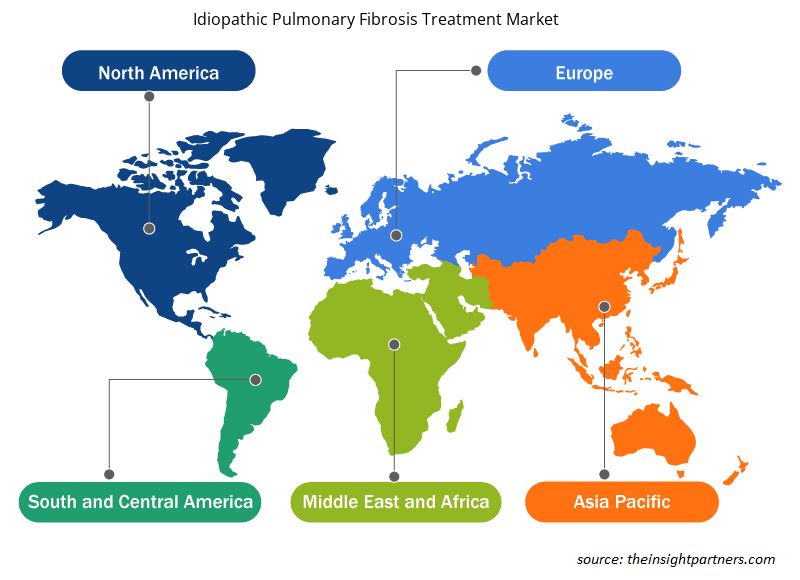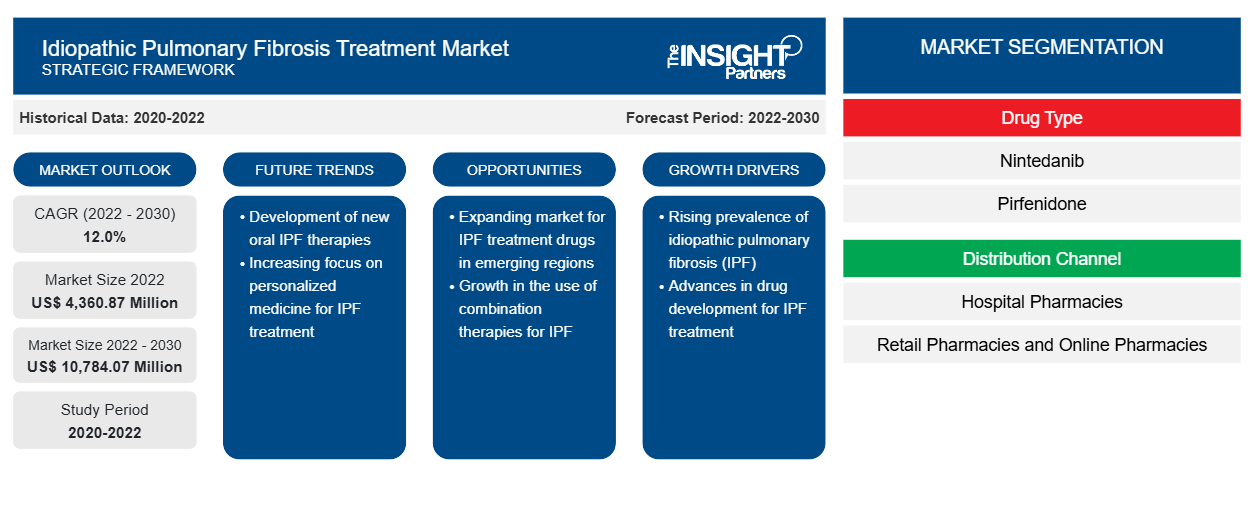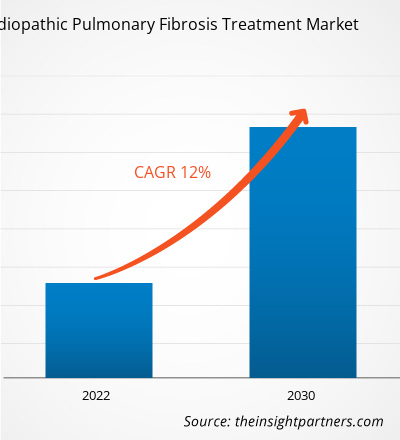[調査レポート] 特発性肺線維症治療の市場規模は、2022年の43億6,087万米ドルから2030年には107億8,407万米ドルに急増すると予測されており、2022年から2030年にかけて市場は12.0%のCAGRで成長すると予測されています。CAGR of 12.0% during 2022–2030.
アナリストの視点:
特発性肺線維症は、肺胞の周囲の組織に影響を及ぼす慢性疾患です。原因不明の理由で肺組織が硬くなり厚くなると発症し、これらの変化により時間の経過とともに肺に永久的な瘢痕が生じ、患者の呼吸が困難になります。現在、特発性肺線維症の正確な治療法はありません。肺リハビリテーション、薬物療法、外科手術などの治療により、肺の損傷が遅くなり、患者の生活の質が向上します。
の 特発性肺線維症の罹患率の増加と喫煙者数の増加により、今後数年間で効果的な治療薬の需要が高まります。特発性肺線維症の治療に効果的な薬を導入するための継続的な研究作業は、将来的に市場にさらなる利益をもたらす可能性があります。現在、先進市場と新興市場の両方で医療費が増加しており、この市場のメーカーは新しい革新的な製品の開発に重点を置いた取り組みを強化することが期待されます。
市場概要:
線維症は、正常な治癒過程の一部として起こる結合組織の沈着、または病理学的過程として起こる過剰組織の沈着です。特発性肺線維症は、肺と肺胞(肺にある気嚢)の結合組織に影響を及ぼします。この症状は、健康な人にとっては退屈ではない日常的な作業中に息切れを引き起こす可能性があります。特発性肺線維症治療市場の成長は、線維症の負担の増大と喫煙者数の増加に起因しています。治療の技術的進歩につながる急速な研究開発活動は、今後数年間で特発性肺線維症治療市場に成長の機会をもたらすと予想されます。
要件に合わせてレポートをカスタマイズする
このレポートの一部、国レベルの分析、Excelデータパックなど、あらゆるレポートを無料でカスタマイズできます。また、スタートアップや大学向けのお得なオファーや割引もご利用いただけます。
- このレポートの主要な市場動向を入手してください。この無料サンプルには、市場動向から見積もりや予測に至るまでのデータ分析が含まれます。
市場の推進要因:
増大する負担特発性肺線維症が特発性肺線維症治療市場を牽引
2022年11月に更新された米国肺協会のデータによると、米国では毎年約5万人の特発性肺線維症の新規症例が診断されています。この疾患の症状は、50〜70歳の患者でより顕著です。2022年9月に英国医学雑誌に掲載された記事によると、2021年の専門治療室における特発性肺線維症の推定有病率は10万人あたり36.0人でした。特発性肺線維症を患う患者の数は、加齢、肥満、高血圧(高血圧症)、家族歴などの一般的な危険因子により世界中で増加しており、この疾患は経済にとって大きな社会経済的負担になりつつあります。したがって、特発性肺線維症の患者数の増加は、線維性疾患治療市場の成長を促進します。 fibrotic disease treatment market growth.
セグメント分析:
薬剤の種類に基づいて、特発性肺線維症治療市場は、ニンテダニブ、ピルフェニドン、その他に分類されます。ニンテダニブセグメントは2022年に大きな市場シェアを占めました。その他セグメントは、2022年から2030年の間に46.3%というより高いCAGRを記録すると予想されています。ピルフェニドンとニンテダニブは、線維性疾患の治療に処方される一般的な薬です。
地域分析:
北米は世界の特発性肺線維症治療市場を支配しています。北米の市場規模は2022年に23億6,295万米ドルと評価され、2030年までに55億2,728万米ドルに達すると予測されています。2022年から2030年の間に11.2%のCAGRを記録すると予想されています。北米の特発性肺線維症治療市場は、米国、カナダ、メキシコに分割されています。特発性肺線維症の負担の増加と治療における技術的進歩は、北米の特発性肺線維症治療市場に利益をもたらします。主要な市場プレーヤーによる製品の発売と戦略的イニシアチブも市場の成長に貢献しています。特発性肺線維症を治療するための研究開発活動の増加に伴い、改良された医薬品が市場に導入され、より広い患者プールへの医薬品へのアクセスが向上しています。さらに、この地域での広範な FDA 承認により、企業は技術的に高度な製品を発売するようになります。
特発性肺線維症の罹患率の上昇と医療費の高騰により、ヨーロッパは世界の線維性疾患治療市場で第 2 位のシェアを占めています。ドイツは、医療分野における技術的に高度な製品やサービスへのアクセスが容易なため、ヨーロッパの特発性肺線維症治療市場を独占すると予想されています。
アジア太平洋地域は、2022年から2030年にかけて、世界の特発性肺線維症治療市場で最速のCAGRを記録すると予想されています。予測される市場の成長は、大幅に短い時間で正確な結果を生み出す最先端技術が広く受け入れられ、採用されたことによるものです。この地域のヘルスケア業界は、人工知能、自動化、デジタル変革のイノベーションを活用し、医療専門家の効率と生産性を高めています。さまざまな業界で進行中の変革により、アジア太平洋地域のビジネスと経済が強化され、持続可能な進歩へのダイナミックで前向きなアプローチを備えた最も急速に発展しているハブとしての地位を確立することができます。
主要プレーヤー分析:
特発性肺線維症治療市場の分析は、Genentech, Inc. や Boehringer Ingelheim International GmbH などの主要企業に基づいています。
特発性肺線維症治療市場の地域別洞察
予測期間を通じて特発性肺線維症治療市場に影響を与える地域的傾向と要因は、Insight Partners のアナリストによって徹底的に説明されています。このセクションでは、北米、ヨーロッパ、アジア太平洋、中東、アフリカ、南米、中米にわたる特発性肺線維症治療市場のセグメントと地理についても説明します。

- 特発性肺線維症治療市場の地域別データを入手
特発性肺線維症治療市場レポートの範囲
| レポート属性 | 詳細 |
|---|---|
| 2022年の市場規模 | 43億6,087万米ドル |
| 2030年までの市場規模 | 107億8,407万米ドル |
| 世界のCAGR(2022年 - 2030年) | 12.0% |
| 履歴データ | 2020-2022 |
| 予測期間 | 2022-2030 |
| 対象セグメント | 薬の種類別
|
| 対象地域と国 | 北米
|
| 市場リーダーと主要企業プロフィール |
|
特発性肺線維症治療市場のプレーヤー密度:ビジネスダイナミクスへの影響を理解する
特発性肺線維症治療市場は、消費者の嗜好の変化、技術の進歩、製品の利点に対する認識の高まりなどの要因により、エンドユーザーの需要が高まり、急速に成長しています。需要が高まるにつれて、企業は提供を拡大し、消費者のニーズを満たすために革新し、新たなトレンドを活用し、市場の成長をさらに促進しています。
市場プレーヤー密度とは、特定の市場または業界内で活動している企業または会社の分布を指します。これは、特定の市場スペースに、その市場規模または総市場価値に対してどれだけの競合相手 (市場プレーヤー) が存在するかを示します。
特発性肺線維症治療市場で事業を展開している主要企業は次のとおりです。
- CHベーリンガーインゲルハイムインターナショナルGmbH
- ブリストル・マイヤーズスクイブ社
- F.ホフマン・ラ・ロシュ株式会社
- アストラゼネカ
- 塩野義製薬株式会社
免責事項:上記の企業は、特定の順序でランク付けされていません。

- 特発性肺線維症治療市場のトップキープレーヤーの概要を入手
最近の動向:
特発性肺線維症治療市場の企業では、合併や買収などの無機的および有機的な戦略が広く採用されています。最近の動向をいくつか以下に示します。
- ベーリンガーインゲルハイムは、2023 年 5 月に画期的な IL-11 阻害抗体 BI 765423 の臨床開発を開始しました。第 1 相試験 (NCT05658107) では、健康な被験者を対象に安全性、忍容性、薬物動態を評価することに重点が置かれました。前臨床研究では、この抗 IL-11 薬がさまざまな線維症症例において線維症を阻害し、線維症を逆転させる可能性があることが示されました。
- ベーリンガーインゲルハイムは2022年10月、BI 1015550を評価するFIBRONEER-IPF第3相試験に米国人初の患者を登録しました。BI 1015550は、特発性肺線維症患者の治療薬として発見された実験的ホスホジエステラーゼ4B(PDE4B)阻害剤です。この試験は、特発性肺線維症患者を対象としたFIBRONEER-IPFと、その他の進行性線維化性間質性肺疾患(ILD)の成人を対象としたFIBRONEER-ILDの2つの第3相試験を含むグローバルFIBRONEERプログラムの一部です。
- 2022年9月、Bellerophon Therapeutics, Inc.は、線維性間質性肺疾患(LD)の治療を適応とするINOpulseの現在のREBUILD第3相登録試験の試験規模縮小申請をFDAが受理したことを発表しました。
- 2022年5月、医薬品安全性ソリューションの世界的リーダーであるアリスグローバルは、ベーリンガーインゲルハイムのBRASSデジタルイノベーションを買収しました。この買収により、アリスグローバルはBRASSをLifeSphere Clarityに統合することで、LifeSphereテクノロジープラットフォームを強化することができました。この統合は、業界全体の医薬品安全性監視と患者の安全性の向上に貢献しています。さらに、アリスグローバルは世界中のさまざまな地域で臨床診断事業のプレゼンスを拡大し、世界的な地位を強化しています。
- 2022年3月、大手製薬会社のブリストル マイヤーズ スクイブは、最終的な合併契約を通じて、Turning Point Therapeutics, Inc.を1株当たり76.00米ドルで買収すると発表しました。この買収により、ブリストル マイヤーズ スクイブの製薬市場における世界的な存在感が大幅に強化され、命を救う治療法と治療のポートフォリオを拡大しながら、業界に革新をもたらすための積極的な取り組みが可能になります。
- 過去2年間の分析、基準年、CAGRによる予測(7年間)
- PEST分析とSWOT分析
- 市場規模価値/数量 - 世界、地域、国
- 業界と競争環境
- Excel データセット


- Airport Runway FOD Detection Systems Market
- Integrated Platform Management System Market
- Electronic Shelf Label Market
- Clear Aligners Market
- Europe Industrial Chillers Market
- Space Situational Awareness (SSA) Market
- Passport Reader Market
- Fishing Equipment Market
- Small Satellite Market
- Trade Promotion Management Software Market

Report Coverage
Revenue forecast, Company Analysis, Industry landscape, Growth factors, and Trends

Segment Covered
This text is related
to segments covered.

Regional Scope
North America, Europe, Asia Pacific, Middle East & Africa, South & Central America

Country Scope
This text is related
to country scope.
よくある質問
The global fibrotic diseases treatment market, based on treatment, is segmented into drug type and distribution channel. Based on drug type, the idiopathic pulmonary fibrosis treatment market is segmented into nintedanib, pirfenidone, and others. The nintedanib segment held a larger market share in 2022. The others segment is anticipated to register a higher CAGR of 46.3% during 2022–2030. Pirfenidone and nintedanib are the popular medicines prescribed to treat fibrotic diseases.
By distribution channel, the global idiopathic pulmonary fibrosis treatment market is categorized into hospital pharmacies, retail pharmacies, and online pharmacies. The hospital pharmacies segment held the largest market share in 2022. The online pharmacies segment is anticipated to register the highest CAGR of 17.4% during 2022–2030.
The enteral nutrition market is expected to be valued at US$ 10,784.07 million in 2030.
The fibrotic diseases treatment market was valued at US$ 4,360.87 million in 2022.
The fibrotic diseases treatment market majorly consists of the players such as F. Hoffmann-La Roche Ltd; C.H. Boehringer Ingelheim International GmbH; AstraZeneca.; Bristol-Myers Squibb Company; Shionogi and Co. Ltd.; and Cipla Ltd.
Idiopathic pulmonary fibrosis is a chronic condition that affects the tissue surrounding the alveoli in the lungs. It develops when lung tissues become stiff and thick for unknown reasons, and these changes result in permanent scarring in the lungs over time, which makes breathing difficult among patients. Currently, there is no precise cure for idiopathic pulmonary fibrosis. Treatments such as pulmonary rehabilitation, medicines, and surgical procedures slow down lung damage and help enhance the quality of patients’ lives.
The growth of the idiopathic pulmonary fibrosis treatment market is attributed to the surging burden of idiopathic pulmonary fibrosis and the increasing number of people smoking cigarettes.
Trends and growth analysis reports related to Life Sciences : READ MORE..
The List of Companies - Fibrotic Diseases Treatment Market
- C.H. Boehringer Ingelheim International GmbH
- Bristol-Myers Squibb Company
- F. Hoffmann-La Roche Ltd
- AstraZeneca
- Shionogi and Co. Ltd.
- Cipla Ltd
- Others
The Insight Partners performs research in 4 major stages: Data Collection & Secondary Research, Primary Research, Data Analysis and Data Triangulation & Final Review.
- Data Collection and Secondary Research:
As a market research and consulting firm operating from a decade, we have published and advised several client across the globe. First step for any study will start with an assessment of currently available data and insights from existing reports. Further, historical and current market information is collected from Investor Presentations, Annual Reports, SEC Filings, etc., and other information related to company’s performance and market positioning are gathered from Paid Databases (Factiva, Hoovers, and Reuters) and various other publications available in public domain.
Several associations trade associates, technical forums, institutes, societies and organization are accessed to gain technical as well as market related insights through their publications such as research papers, blogs and press releases related to the studies are referred to get cues about the market. Further, white papers, journals, magazines, and other news articles published in last 3 years are scrutinized and analyzed to understand the current market trends.
- Primary Research:
The primarily interview analysis comprise of data obtained from industry participants interview and answers to survey questions gathered by in-house primary team.
For primary research, interviews are conducted with industry experts/CEOs/Marketing Managers/VPs/Subject Matter Experts from both demand and supply side to get a 360-degree view of the market. The primary team conducts several interviews based on the complexity of the markets to understand the various market trends and dynamics which makes research more credible and precise.
A typical research interview fulfils the following functions:
- Provides first-hand information on the market size, market trends, growth trends, competitive landscape, and outlook
- Validates and strengthens in-house secondary research findings
- Develops the analysis team’s expertise and market understanding
Primary research involves email interactions and telephone interviews for each market, category, segment, and sub-segment across geographies. The participants who typically take part in such a process include, but are not limited to:
- Industry participants: VPs, business development managers, market intelligence managers and national sales managers
- Outside experts: Valuation experts, research analysts and key opinion leaders specializing in the electronics and semiconductor industry.
Below is the breakup of our primary respondents by company, designation, and region:

Once we receive the confirmation from primary research sources or primary respondents, we finalize the base year market estimation and forecast the data as per the macroeconomic and microeconomic factors assessed during data collection.
- Data Analysis:
Once data is validated through both secondary as well as primary respondents, we finalize the market estimations by hypothesis formulation and factor analysis at regional and country level.
- Macro-Economic Factor Analysis:
We analyse macroeconomic indicators such the gross domestic product (GDP), increase in the demand for goods and services across industries, technological advancement, regional economic growth, governmental policies, the influence of COVID-19, PEST analysis, and other aspects. This analysis aids in setting benchmarks for various nations/regions and approximating market splits. Additionally, the general trend of the aforementioned components aid in determining the market's development possibilities.
- Country Level Data:
Various factors that are especially aligned to the country are taken into account to determine the market size for a certain area and country, including the presence of vendors, such as headquarters and offices, the country's GDP, demand patterns, and industry growth. To comprehend the market dynamics for the nation, a number of growth variables, inhibitors, application areas, and current market trends are researched. The aforementioned elements aid in determining the country's overall market's growth potential.
- Company Profile:
The “Table of Contents” is formulated by listing and analyzing more than 25 - 30 companies operating in the market ecosystem across geographies. However, we profile only 10 companies as a standard practice in our syndicate reports. These 10 companies comprise leading, emerging, and regional players. Nonetheless, our analysis is not restricted to the 10 listed companies, we also analyze other companies present in the market to develop a holistic view and understand the prevailing trends. The “Company Profiles” section in the report covers key facts, business description, products & services, financial information, SWOT analysis, and key developments. The financial information presented is extracted from the annual reports and official documents of the publicly listed companies. Upon collecting the information for the sections of respective companies, we verify them via various primary sources and then compile the data in respective company profiles. The company level information helps us in deriving the base number as well as in forecasting the market size.
- Developing Base Number:
Aggregation of sales statistics (2020-2022) and macro-economic factor, and other secondary and primary research insights are utilized to arrive at base number and related market shares for 2022. The data gaps are identified in this step and relevant market data is analyzed, collected from paid primary interviews or databases. On finalizing the base year market size, forecasts are developed on the basis of macro-economic, industry and market growth factors and company level analysis.
- Data Triangulation and Final Review:
The market findings and base year market size calculations are validated from supply as well as demand side. Demand side validations are based on macro-economic factor analysis and benchmarks for respective regions and countries. In case of supply side validations, revenues of major companies are estimated (in case not available) based on industry benchmark, approximate number of employees, product portfolio, and primary interviews revenues are gathered. Further revenue from target product/service segment is assessed to avoid overshooting of market statistics. In case of heavy deviations between supply and demand side values, all thes steps are repeated to achieve synchronization.
We follow an iterative model, wherein we share our research findings with Subject Matter Experts (SME’s) and Key Opinion Leaders (KOLs) until consensus view of the market is not formulated – this model negates any drastic deviation in the opinions of experts. Only validated and universally acceptable research findings are quoted in our reports.
We have important check points that we use to validate our research findings – which we call – data triangulation, where we validate the information, we generate from secondary sources with primary interviews and then we re-validate with our internal data bases and Subject matter experts. This comprehensive model enables us to deliver high quality, reliable data in shortest possible time.


 このレポートの無料サンプルを入手する
このレポートの無料サンプルを入手する